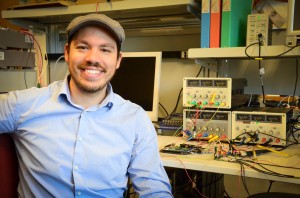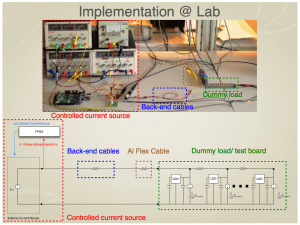If physicists had it their way, detectors of the future would be powered with air. They want no material and no electronic noise to disturb their measurements. Powering by air isn’t a realistic option, so electrical engineers are tackling the challenge, putting a lot of effort into keeping noise down and material out. One of them is Cristian Fuentes at CERN. His latest project: power pulsing for the CLIC detector.
Using a power-pulsing scheme, the CLIC detector, much like the ILC detectors, could save space that would otherwise have to be set aside for cooling mechanisms. Operating electronics produce heat, which would have to be carried away to keep the detectors operational; electronics on stand-by don’t, at least not as much. Of course the CLIC bunch structure is different to that of the ILC, but the fundamental ideas – and the challenges – are very similar. The detector has to function when collisions happen, but can go to micro-sleep in the microsecond-periods of calm in between. This means that less heat is produced, so less heat has to be dissipated, which in turn means that the mass needed for cooling can be reduced.
After completing his PhD in electronic engineering on DC-DC converters for the trackers of the High Luminosity Large Hadron Collider – CERN (HL-LHC) experiments, Cristian Fuentes joined the Linear Collider Detector group at CERN as a research fellow to help them with their power-pulsing. There already are detector prototype chips, the CLICpix chip, for example, that can take care of their own status, meaning they gather all the data and then go back to an idle state before the next collisions happen. However, they still have to get their power from somewhere, and Fuentes is investigating a solution based on capacitors – a kind of tiny rechargeable battery – built into the detector structure. “I am trying to find the best capacitors and the best way to charge them again,” says the Chilean.
The detector structure, much to the regret of collision-curious particle physicists, consists of more than just the detector itself. Readout infrastructure, mechanical support and cables all add to the material budget that could otherwise be used for more collision-relevant detector material. So the idea is that the required elements to power the detectors should be as small as possible. Cooling is a potential space eater as well, so the idea is to cool the capacitors and the rest of the electronics with air. All this intricate interplay of factors poses challenges that Fuentes is trying to tackle in a lab at CERN.
“The energy will be stored in the capacitors, but other elements are needed to distribute the power to the detector chips. For instance, cables are needed to provide the current to the capacitors and voltage-regulators to provide the constant voltage that the detector chips require,” explains Fuentes.
His most difficult challenge at the moment is to keep the material of all these elements as low as possible. For instance, in order to reduce the impact of the cables, their traditional material, copper, will be replaced by aluminium. This, for example, reduces the cable mass by a factor of four, which makes aluminium more attractive than copper for particle physics usage. As this is not the standard procedure in the industry, flexible printed circuit board (PCB) prototypes were built at CERN to evaluate their behaviour.
In a similar way, other capacitor technologies were evaluated beside conventional technologies like ceramic capacitors. One of these technologies are silicon capacitors, which showed good performance and low material contribution. Fuentes tested a setup of several silicon capacitors, aluminium flexible PCBs and voltage regulators in the lab and found that the principles of the proposed solution work.
“With today’s technology, we are at the limit of CLIC material requirements,” says Fuentes, “but I am sure that the technology will evolve and that by the time these detectors are actually built we will fulfil the design goals set today.”
His next step is to find the best way to stack up and interconnect the power elements – PCBs, capacitors and voltage-regulators – to the CLICpix chips. This requires the study of new 3D packaging technologies.



Recent Comments